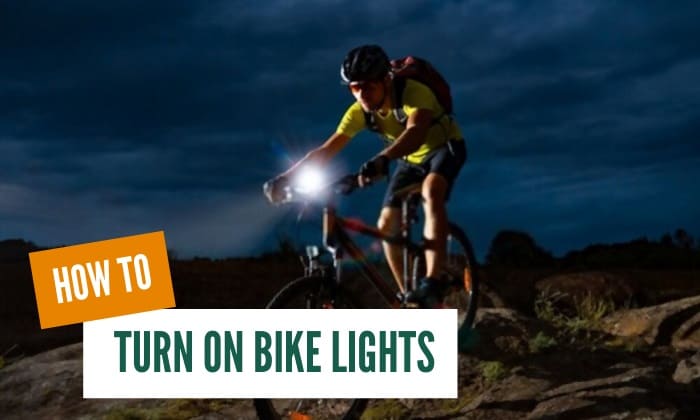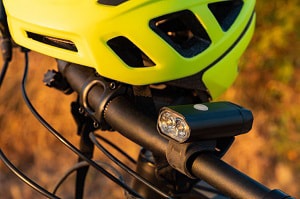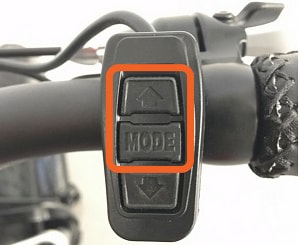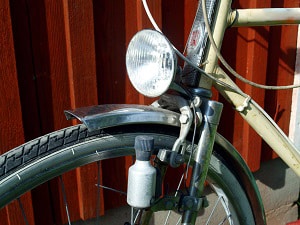Riding a bicycle in low visibility is dangerous, and we need lighting solutions to keep us safe. However, one light is not enough and we may need to use different types together depending on our needs. It may become confusing how to turn on bike lights considering the number of ways to use them.
Let’s take a look at some of the common ways to light up my bike. It’s a good idea to have some familiarity with them just in case.
Keep reading to learn more.

What You’ll Need
- Bicycle light (2 or more recommended for each bike)
Optional depending on the light model:
- Batteries (for standard lights)
- Charging cable
- USB drive and cable
- App installed on a mobile device
Ways to Turn On Bicycle Lights
1. Use the On/Off switch

he first method of turning bicycle lights on is simply pressing a switch that may be located near the handles or on the device. This is common for battery-operated units such as a bicycle flashlight.
They can have just one button for turning on and off and may include mode controls such as blink settings on that same button. For such models, you control them by pressing that single button multiple times.
Some less orthodox designs still use a similar control mechanism for turning the device on or off. The bike ball light is turned on by pressing it.
2. Control with a Mobile app、

Another way to turn on bicycle lights is by using an app on your mobile device. By using an accompanying program installed on your smartphone, you can turn bike lights on and even control how they behave. Control options include details such as intensity, beam settings, and flash patterns.
Some models even support synchronization between multiple lights to make them available for use simultaneously at the push of a single button.
3. Turn on Rad Power Bike light with the control panel

Some e-bikes use a control panel for their functions including the brake and turn light on electric bike. The Rad Power Bike brand’s models are good examples.
To turn on the headlight on a power bike, you need to press and hold the mode and up buttons on the panel at the same time. Do note that if lights are connected to the e-bike’s motor, you will need the motor to be running for the lights to operate.
4. Turning the wheel

Some lights do not need to be switched on for them to work. Dynamo-powered lights are a good example of this.
The wheel’s rotation is what can turn on bike dynamo light and simple models light up as soon as you start pedaling. Some turn on when you start braking or if you decelerate.
Some models turn on bike reflectors or lights using an auto-sense feature that detects specific conditions when riding a bicycle. These not only control power but also beam and flash settings.
Frequently Asked Questions

What are the different types of bike lights?
They can be categorized depending on where they are on the bicycle; front, rear, and side. Front lights are mostly used to improve sight when riding a bike in low-visibility situations and these need to be bright to be effective.
Rear and side lights are used to make cyclists easier to identify while on the road. The rear ones are recommended to be red.
Sidelights help make you visible from the left or right and are important because many accidents happen at intersections where the front and rear lights may not be enough.
How many lights do you need?
Most places require two, one each for the front and rear, however, it is recommended to use more. Front lights may be categorized as lights to see and lights to be seen; it is useful to have both.
It’s also a good idea to have sidelights in addition to rear ones and having a bike turn light can be even more helpful. Covering all sides will ensure visibility and may keep you safe.
How do bike lights work?
Many are powered by a battery or a bike lights generator. and are turned on using a button or switch. Devices for electric bikes such as a Bafang headlight are hooked up to a motor instead but still work similarly.
Dynamo lights are a bit different because turning the wheel is what powers them. The dynamo is located at the wheel hub and may even have a small battery to store energy for when the wheel stops turning.
Why won’t they turn on?
The most likely cause for the bike light not functioning is that it ran out of power. A headlight for a bicycle is prone to the battery getting drained quickly because its high intensity drains more energy, especially at the max setting.
Conclusion
Now you know the common ways on how to turn on bike lights. These are extremely important when riding a bicycle and may even be required by law depending on where you are. Make sure to use them well to help keep yourself safe.
What type of lights do you use? How many do you feel are necessary to keep safe while riding a bike? Tell us your thoughts in the comments section below.
Always ride safely.
 Shuangye ebike
Shuangye ebike
